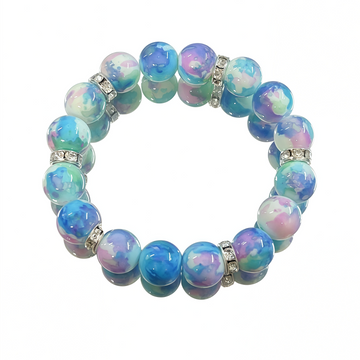Ultrasonic cleaning can effectively remove stains on the surface of stone bracelets, but it is necessary to carefully select the applicable material and control the cleaning parameters.
First, applicable stone types
Recommended material
High-hardness stones: diamonds, rubies, sapphires, jade (unoptimized), crystals, etc.
Metal-inlaid stone: Hard gemstones inlaid in plain gold (such as 18K gold, platinum), but it is necessary to avoid deformation of the setting claws.
Use materials with caution.
Soft stones: pearls, corals, amber, turquoise, shells, etc. (Porous structures are prone to damage).
Optimized stone treatment: emerald (oil, resin optimization), dyed sapphire (color may fade).
Cracked stone: Gemstones with cracks or bubbles inside (ultrasonic waves may expand the cracks).
Second, control of cleaning parameters
Selection of cleaning solution
Recommendation: Distilled water or special jewelry cleaner (avoid corrosive components).
Use with caution: Tap water (chlorine may affect diamonds), dishwashing liquid (rinse thoroughly with a small amount).
Cleaning time
Recommendation: 2-3 minutes (adjust according to the degree of stain).
Use with caution: More than 5 minutes (may cause gemstone loosening or metal fatigue).
Temperature control
Recommendation: Room temperature or warm water around 30℃ (to avoid cracking of the stone caused by high temperature).
Use with caution: Hot water above 80℃ (may damage heat-sensitive stones such as opal and opal).
Third, operational skills
Inlaid bracelets
Method: Use tweezers to hold the ring support and suspend it in the air for cleaning, avoiding direct contact with the cleaning tank.
Reason: To reduce the risk of prong deformation or gemstone detachment.
Treatment of thick stains
Method: Add a small amount of detergent to specific areas, rub slightly and then wash.
Note: To avoid residue of detergent, rinse thoroughly.
Post-cleaning treatment
Method: Rinse with clean water and dry (avoid water stains), and check if the gemstone is loose.
Reason: Ultrasonic vibration may cause gemstones to loosen or wear out.
Fourth, Risks and Precautions
Risk of gemstone detachment
Reason: Ultrasonic vibration may cause gemstones that are not firmly set to fall off.
Suggestion: Check the gemstone setting before and after cleaning. Use with caution for complex Settings.
Risk of material damage
The reason is that soft stone is prone to damage by high-frequency bands, while heat-sensitive stone may be damaged due to temperature changes.
Suggestion: Avoid washing materials such as pearls and opal. If necessary, conduct a small-scale test first.
Optimize the handling of failure risks
Reason: Ultrasonic waves may wear down or remove the surface treatment layer of optimized materials such as emeralds.
Suggestion: Ultrasonic cleaning should be used with caution for stone that has undergone optimized treatment.
Fifth, alternative solutions
Manual cleaning
Applicable scenarios: Soft stone or complex inlaid patterns.
Method: Use a soft-bristled toothbrush dipped in neutral detergent to gently brush, rinse with clean water and dry.
Professional cleaning
Applicable scenarios: Stone bracelets of high value or with complex inlays.
Method: Send it to a professional jewelry store and clean it with professional equipment and techniques.
By reasonably controlling the ultrasonic cleaning parameters and choosing the appropriate stone, the surface stains of stone bracelets can be effectively cleaned, while avoiding the risk of damage. For stones whose applicability is uncertain, it is recommended to conduct a small-scale test first or consult a professional.







